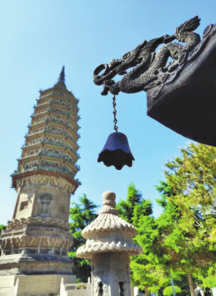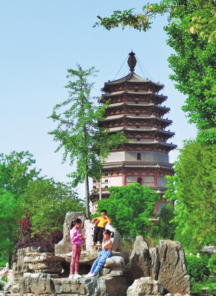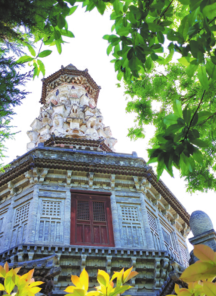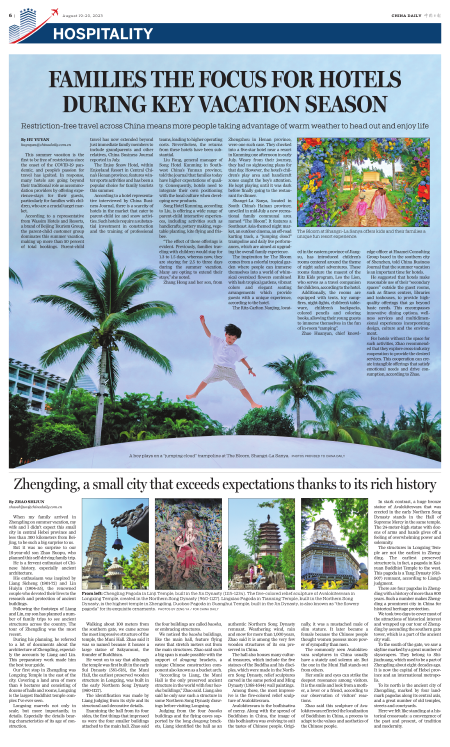
Chengling Pagoda in Linji Temple, built in the Jin Dynasty (1115-1234).

The five-colored relief sculpture of Avalokitesvara in Longxing Temple, created in the Northern Song Dynasty (960-1127).

Lingxiao Pagoda in Tianning Temple, built in the Northern Song Dynasty, is the highest temple in Zhengding.

Duobao Pagoda in Guanghui Temple, built in the Jin Dynasty, is also known as "the flowery pagoda" for its exquisite ornaments.
When my family arrived in Zhengding on summer vacation, my wife and I didn't expect this small city in central Hebei province and less than 300 kilometers from Beijing, to be such a big surprise to us.
But it was no surprise to our 16-year-old son Zhao Ruopu, who planned this self-driving family trip.
He is a fervent enthusiast of Chinese history, especially ancient architecture.
His enthusiasm was inspired by Liang Sicheng (1901-72) and Lin Huiyin (1904-55), the renowned couple who devoted their lives to the research and protection of ancient buildings.
Following the footsteps of Liang and Lin, my son has planned a number of family trips to see ancient structures across the country. The tour of Zhengding was the most recent.
During his planning, he referred to a lot of documents about the architecture of Zhengding, especially the accounts by Liang and Lin. This preparatory work made him the best tour guide.
Our first stop in Zhengding was Longxing Temple in the east of the city. Covering a land area of more than 8 hectares and consisting of dozens of halls and rooms, Longxing is the largest Buddhist temple complex I've ever seen.
Longxing marvels not only in scale, but more importantly, in details. Especially the details bearing characteristics of its age of construction.
Walking about 100 meters from the southern gate, we came across the most impressive structure of the temple, the Muni Hall. Zhao said it was so named because it houses a large statue of Sakyamuni, the founder of Buddhism.
He went on to say that although the temple was first built in the early Sui Dynasty (581-618), the Muni Hall, the earliest preserved wooden structure in Longxing, was built in the early Northern Song Dynasty (960-1127).
The identification was made by Liang judging from its style and its structural and decorative details.
Examining the hall from its four sides, the first things that impressed us were the four smaller buildings attached to the main hall. Zhao said the four buildings are called baosha, or embracing structures.
We noticed the baosha buildings, like the main hall, feature flying eaves that stretch meters out from the main structures. Zhao said such a big span is made possible with the support of dougong brackets, a unique Chinese construction component also known as a bucket arch.
"According to Liang, the Muni Hall is the only preserved ancient structure in the world with four baosha buildings," Zhao said. Liang also said he only saw such a structure in some Northern Song Dynasty drawings before visiting Longxing.
Judging from the four baosha buildings and the flying eaves supported by the long dougong brackets, Liang identified the hall as an authentic Northern Song Dynasty remnant. Weathering wind, rain and snow for more than 1,000 years, Zhao said it is among the very few wooden structures of its era preserved in China.
The hall also houses many cultural treasures, which include the five statues of the Buddha and his disciples, which were made in the Northern Song Dynasty, relief sculptures carved in the same period and Ming Dynasty (1368-1644) wall paintings.
Among these, the most impressive is the five-colored relief sculpture of Avalokitesvara.
Avalokitesvara is the bodhisattva of mercy. Along with the spread of Buddhism in China, the image of this bodhisattva was evolving to suit the tastes of Chinese people. Originally, it was a mustached male of slim stature. It later became a female because the Chinese people thought women possess more power of sympathy than men.
The commonly seen Avalokitesvara sculptures in China usually have a stately and solemn air. But the one in the Muni Hall stands out from others.
Her smile and eyes can strike the deepest resonance among visitors. It is the smile and look from a mother, a lover or a friend, according to our observation of visitors' reactions.
Zhao said this sculpture of Avalokitesvara reflected the localization of Buddhism in China, a process to adapt to the values and aesthetics of the Chinese people.
In stark contrast, a huge bronze statue of Avalokitesvara that was erected in the early Northern Song Dynasty stands in the Hall of Supreme Mercy in the same temple. The 24-meter-high statue with dozens of arms and hands gives off a feeling of overwhelming power and solemnity.
The structures in Longxing Temple are not the earliest in Zhengding. The earliest preserved structure is, in fact, a pagoda in Kaiyuan Buddhist Temple to the west. This pagoda is a Tang Dynasty (618-907) remnant, according to Liang's judgment.
There are four pagodas in Zhengding with a history of more than 800 years. Such a number makes Zhengding a prominent city in China for historical heritage protection.
We took two days to cover most of the attractions of historical interest and wrapped up our tour of Zhengding by ascending the southern gate tower, which is a part of the ancient city wall.
To the south of the gate, we saw a skyline marked by a great number of skyscrapers. They belong to Shi�0�2-jiazhuang, which used to be a part of Zhengding about eight decades ago. It is now the capital of Hebei province and an international metropolis.
To its north is the ancient city of Zhengding, marked by four landmark pagodas along its central axis, and a great number of old temples, streets and courtyards.
Here we felt like standing at a historical crossroads: a convergence of the past and present, of tradition and modernity.
zhaoshijun@chinadaily.com.cn

